Saint Lucy
Lucia of Syracuse (283–304), also called Saint Lucia (Latin: Sancta Lucia) or Saint Lucy, was a Christian martyr who died during the Diocletianic Persecution. She is venerated as a saint in the Roman Catholic, Anglican, Lutheran, and Eastern Orthodox churches. She is one of eight women (including Saint Mary) explicitly commemorated by Roman Catholics in the Canon of the Mass. Her traditional feast day, known in Europe as Saint Lucia's Day, is observed by Western Christians on 13 December. Lucia of Syracuse was honored in the Middle Ages and remained a well-known saint in early modern England.[3]
Saint Lucia (Saint Lucy) | |
|---|---|
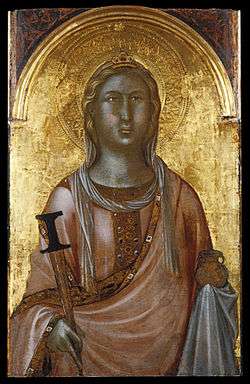 Saint Lucy, by Niccolò di Segna mid 14th-century Sienese painting, circa 1340. The saint holds the dagger with which she was ultimately executed and the lamp, her attribute. | |
| Virgin and Martyr | |
| Born | c. 283[1] Syracuse, Roman Empire |
| Died | 304 AD Syracuse, Western Roman Empire |
| Venerated in |
|
| Canonized | Pre-congregation |
| Major shrine | San Geremia, Venice |
| Feast |
|
| Attributes | cord; eyes; eyes on a dish; lamp; swords; woman hitched to a yoke of oxen; woman in the company of Saint Agatha, Saint Agnes of Rome, Barbara, Catherine of Alexandria, and Saint Thecla; woman kneeling before the tomb of Saint Agatha |
| Patronage | The blind; martyrs; Perugia, Italy; Mtarfa, Malta; epidemics; salesmen; Syracuse, Italy; throat infections; writers; Sasmuan, Pampanga Philippines |
Sources
The oldest record of her story comes from the fifth-century Acts of the Martyrs.[4] The single fact upon which various accounts agree is that a disappointed suitor accused Lucy of being a Christian, and she was executed in Syracuse, Sicily, in the year 304 during the Diocletianic Persecution.[5] Her veneration spread to Rome, and by the sixth century to the whole Church. The oldest archaeological evidence comes from the Greek inscriptions from the Catacombs of St. John in Syracuse. Jacobus de Voragine's Legenda Aurea was the most widely read version of the Lucy legend in the Middle Ages. In medieval accounts, Saint Lucy's eyes were gouged out prior to her execution.
Life
All the details of her life are the conventional ones associated with female martyrs of the early fourth century. John Henry Blunt views her story as a Christian romance similar to the Acts of other virgin martyrs.[6]
According to the traditional story, Lucy was born of rich and noble parents about the year 283. Her father was of Roman origin,[1] but died when she was five years old,[7] leaving Lucy and her mother without a protective guardian. Her mother's name Eutychia seems to indicate that she came from a Greek background.[1]
Like many of the early martyrs, Lucy had consecrated her virginity to God, and she hoped to distribute her dowry to the poor.[1] However, Eutychia, not knowing of Lucy's promise, and suffering from a bleeding disorder, feared for Lucy's future. She arranged Lucy's marriage to a young man of a wealthy pagan family.
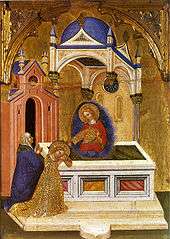
Saint Agatha had been martyred 52 years before during the Decian persecution. Her shrine at Catania, less than 50 miles from Syracuse, attracted a number of pilgrims; many miracles were reported to have happened through her intercession. Eutychia was persuaded to make a pilgrimage to Catania, in hopes of a cure. While there, St. Agatha came to Lucy in a dream and told her that because of her faith her mother would be cured and that Lucy would be the glory of Syracuse, as she was of Catania. With her mother cured, Lucy took the opportunity to persuade her mother to allow her to distribute a great part of her riches among the poor.[1]
Eutychia suggested that the sums would make a good bequest, but Lucy countered, "...whatever you give away at death for the Lord's sake you give because you cannot take it with you. Give now to the true Savior, while you are healthy, whatever you intended to give away at your death."[8]
News that the patrimony and jewels were being distributed came to Lucy's betrothed, who denounced her to Paschasius, the Governor of Syracuse. Paschasius ordered her to burn a sacrifice to the emperor's image. When she refused, Paschasius sentenced her to be defiled in a brothel.
The Christian tradition states that when the guards came to take her away, they could not move her even when they hitched her to a team of oxen. Bundles of wood were then heaped about her and set on fire, but would not burn. Finally, she met her death by the sword[1] thrust into her throat.[9]
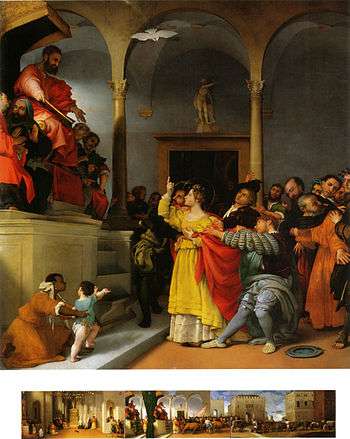
Absent in the early narratives and traditions, at least until the fifteenth century, is the story of Lucia tortured by eye-gouging. According to later accounts, before she died she foretold the punishment of Paschasius and the speedy end of the persecution, adding that Diocletian would reign no more, and Maximian would meet his end.[1] This so angered Paschasius that he ordered the guards to remove her eyes. Another version has Lucy taking her own eyes out in order to discourage a persistent suitor who admired them. This is one of the reasons that Lucy is the patron saint of those with eye illnesses. When her body was prepared for burial in the family mausoleum it was discovered that her eyes had been miraculously restored.[7]
Veneration
By the sixth century, her story was sufficiently widespread that she appears in the Sacramentary of Pope Gregory I.[6] She is also commemorated in the ancient Roman Martyrology.[1] St. Aldhelm (English, died in 709) and later the Venerable Bede (English, died in 735) attest that her popularity had already spread to England, where her festival was kept in England until the Protestant Reformation, as a holy day of the second rank in which no work but tillage or the like was allowed.[7]
Sigebert of Gembloux wrote a mid-eleventh century passio, to support a local cult of Lucy at Metz.[10]
The General Roman Calendar formerly had a commemoration of Saints Lucy and Geminianus on 16 September. This was removed in 1969, as a duplication of the feast of her dies natalis on 13 December and because the Geminianus in question, mentioned in the Passio of Saint Lucy, seems to be a fictitious figure,[2] unrelated to the Geminianus whose feast is on 31 January.
Relics
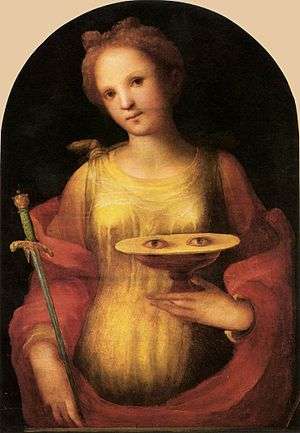
Sigebert (1030–1112), a monk of Gembloux, in his sermo de Sancta Lucia, chronicled that her body lay undisturbed in Sicily for 400 years, before Faroald II, Duke of Spoleto, captured the island and transferred the body to Corfinium in the Abruzzo, Italy. From there it was removed by the Emperor Otho I in 972 to Metz and deposited in the church of St. Vincent. It was from this shrine that an arm of the saint was taken to the monastery of Luitburg in the Diocese of Speyer – an incident celebrated by Sigebert in verse.[1]
The subsequent history of the relics is not clear.[1] According to Umberto Benigni, Stephen II (768) sent the relics of St. Lucy to Constantinople for safety against the Saracen incursions.[11] On their capture of Constantinople in 1204, the French found some relics attributed to Saint Lucy in the city, and Enrico Dandolo, Doge of Venice, secured them for the monastery of St. George at Venice.[12] In 1513 the Venetians presented to Louis XII of France the saint's head, which he deposited in the cathedral church of Bourges. Another account, however, states that the head was brought to Bourges from Rome, where it had been transferred during the time when the relics rested in Corfinium.[1]
The remainder of the relics remain in Venice: they were transferred to the church of San Geremia when the church of Santa Lucia was demolished in 1861 to make way for the new railway terminus. A century later, on 7 November 1981, thieves stole all her bones, except her head. Police recovered them five weeks later, on her feast day. Other parts of the corpse have found their way to Rome, Naples, Verona, Lisbon, Milan, as well as Germany, France and Sweden.[12]
Patronage
Lucy's Latin name Lucia shares a root (luc-) with the Latin word for light, lux. A number of traditions incorporate symbolic meaning of St. Lucy as the bearer of light in the darkness of winter, her feast day being 13 December. Because some versions of her story relate that her eyes were removed, either by herself or by her persecutors, she is the patron saint of the blind.[4]
She is also the patron saint of authors, cutlers, glaziers, laborers, martyrs, peasants, saddlers, salesmen, stained glass workers, and of Perugia, Italy. She is invoked against hemorraghes, dysentery, diseases of the eye, and throat infections.[13]
St. Lucy is the patroness of Syracuse in Sicily, Italy.[13] At the Piazza Duomo in Syracuse, the church of Santa Lucia alla Badia houses the painting "Burial of St. Lucy (Caravaggio)". She is also the patron saint of the coastal town of Olón, Ecuador, which celebrates with a week-long festival culminating on the feast day 13 December.
The Caribbean island of Saint Lucia, one of the Windward Islands in the Lesser Antilles, is named after her.
Iconography
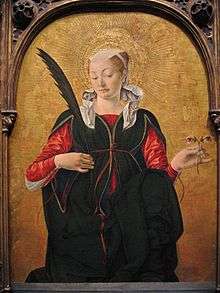
The emblem of eyes on a cup or plate apparently reflects popular devotion to her as protector of sight, because of her name, Lucia (from the Latin word "lux" which means "light").[14][15] In paintings St. Lucy is frequently shown holding her eyes on a golden plate. Lucy was represented in Gothic art holding a dish with two eyes on it. She also holds the palm branch, symbol of martyrdom and victory over evil.[7] Other symbolic images include a lamp, dagger, or two oxen.[13]
In literature
Dante
Lucia appears in Dante's Inferno Canto II as the messenger sent to Beatrice from "The blessed Dame" (the Virgin Mary), to rouse Beatrice to send Virgil to Dante's aid. Henry Fanshawe Tozer identifies Lucia as representing "illuminative grace".[16] According to Robert Pogue Harrison and Rachel Jacoff, Lucia's appearance in this intermediary role is to reinforce the scene in which Virgil tries to fortify Dante's courage to begin the journey through the inferno.
In the Purgatorio IX:52–63, Lucy carries the sleeping Dante to the entrance to purgatory. Then in Paradiso XXXII Dante places her opposite Adam within the Mystic Rose in Canto XXXII of the Paradiso. Lucy may also be seen as a figure of Illuminating Grace or Mercy or even Justice.[17]
Donne
Her feast day was commonly described as the shortest day of the year, as it is in John Donne's poem, "A Nocturnal upon St. Lucie's Day, being the shortest day" (1627). The poem begins with: "'Tis the year's midnight, and it is the day's".[18]
Lucia is also the protagonist of a Swedish novel: "Ett ljus i mörkret" ("A light in the darkness") by Agneta Sjödin.
Popular celebration
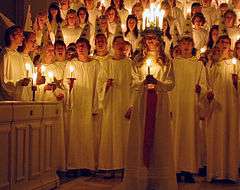
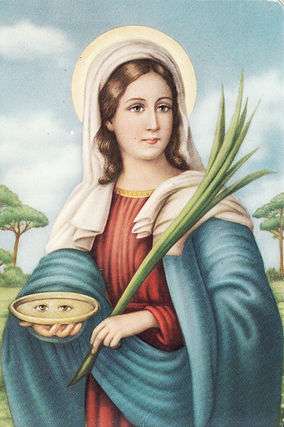
Lucy's feast is on 13 December, in Advent. Her feast once coincided with the Winter Solstice, the shortest day of the year, before calendar reforms, so her feast day has become a festival of light.[7]
This is particularly seen in Scandinavian countries, with their long dark winters. There, a young girl dressed in a white dress and a red sash (as the symbol of martyrdom) carries palms and wears a crown or wreath of candles on her head. In Denmark, Norway and Sweden, girls dressed as Lucy carry rolls and cookies in procession as songs are sung. It is said that to vividly celebrate St. Lucy's Day will help one live the long winter days with enough light.[19]
A special devotion to St. Lucy is practiced in the Italian regions of Lombardy, Emilia-Romagna, Veneto, Friuli Venezia Giulia, Trentino-Alto Adige, in the North of the country, and Sicily and Calabria, in the South, as well as in the Croatian coastal region of Dalmatia. The feast is a Catholic-celebrated holiday with roots that can be traced to Sicily. On the 13th of every December it is celebrated with large traditional feasts of home-made pasta and various other Italian dishes, with a special dessert of wheat in hot chocolate milk. The large grains of soft wheat are representative of her eyes and are a treat only to be indulged in once a year. In the north of Italy Saint Lucy brings gift to kids between 12 and 13 December. Traditionally a bouquet of hay is put outside of the house for Lucy's Donkey and food in the house for Lucy to refresh them after the long night bringing gifts to every kid. In small towns, a parade with Saint Lucy is held the evening of the 12th when she goes through the main streets of the town munching sweets and candy from her cart, always together with her donkey.
A Hungarian custom is to plant wheat in a small pot on St. Lucy's feast. By Christmas green sprouts appear, signs of life coming from death. The wheat is then carried to the manger scene as the symbol of Christ in the Eucharist.
In the Philippines, villagers from Barangay Sta. Lucia in Magarao, Camarines Sur, hold a novena to St. Lucy nine days before her feast. A procession of the saint's image is held every morning at the poblacion or village centre during the nine days leading up to St. Lucy's Day, attracting devotees from other parts of the Bicol Region. Hymns to the saint, known as the Gozos, as well as the Spanish version of the Ave Maria are chanted during the dawn procession, which is followed by a Mass.
The feast day is also commemorated in Barangay Sucad in[20] Apalit Pampanga after the traditional nine-day novena, where a whole day celebration is observed through Eucharistic Masses, festivals and the procession of the religious sculpture of Sta. Lucia in the evening before the evening Mass.
List of dedications to Saint Lucy
Churches
- Saint Lucia's Church, Upton Magna, Shropshire, England
- Chiesa di Santa Lucia, Belpasso, Catania, Sicily, Italy
- Saint Lucy's chapel, cathedral, Syracuse, Sicily, Italy
- Saint Lucy's Church, Methuen, Massachusetts, United States
- Church of Saint Lucia (Iglesia de Santa Lucía), Mérida, Mexico
- St. Lucia Church, Puthoor, India
- St. Lucia Church, Erayumanthurai, India
- St. Lucia's Cathedral, Kotahena, Sri Lanka
- Church of San Geremia and the grave of Saint Lucy, Venice, Italy
- Church of St. Lucia at the Tomb[21] (Church of St. Lucia Outside the Walls), Syracuse, Sicily, Italy
- Chiesa di Santa Lucia alla Badia, also Syracuse, Sicily, Italy
- St. Lucy Catholic Church, Highland Beach, Florida, United States
- Église Sainte-Lucie de Vallières, Metz, Moselle, France
- St. Lucy's National Shrine at Micoud, Saint Lucia
- St. Lucy, Virgin and Martyr Parish, Capalonga, Camarines Norte, Philippines
- Sta. Lucia Parish, Barangay Sta. Lucia, Sasmuan, Pampanga, Philippines
- Sta. Lucia Parish, Barangay Manggahan, Pasig City, Philippines
- Santa Lucia in San Jose Recoletos Parish Church, Cebu City, Philippines
- Sta. Lucia Chapel, Barangay Sta. Lucia, Magarao, Camarines Sur, Philippines
- Sta. Lucia Chapel, Barangay Sta. Lucia, Samal, Bataan
- Sta. Lucia Chapel, Barangay Sta. Lucia, San Miguel, Bulacan
- Sta. Lucia Chapel, Barangay Sta. Lucia, San Juan City, Metro Manila, Philippines
- Sta. Lucia Chapel, Barangay Sta. Lucia, San Luis, Pampanga
- Sta. Lucia Chapel, Barangay Punturin, Valenzuela City, Metro Manila, Philippines
- Sta. Lucia Chapel, Barangay Sta. Lucia, Lubao, Pampanga, Philippines
- Sta. Lucia Chapel, Barangay Sta. Lucia, Masantol, Pampanga, Philippines
- Sta. Lucia Chapel, Barangay Sta. Lucia, Sta. Ana, Pampanga, Philippines – CPC rj simbillo
- Sta. Lucia Cupang, Chapel, Arayat, Pampanga, Philippines
- Sta. Lucia Chapel, Barangay Pinulot, Dinalupihan, Bataan
- Sta. Lucia Chapel, Barangay Sucad, Apalit, Pampanga, Philippines
- Sta. Lucia Chapel, Valenzuela, Metro Manila, Philippines
- Sta. Lucia Mini-Parish, De Castro Subd., Barangay Sta. Lucia, Pasig City, Philippines
- Namayan Chapel, Barangay Namayan, City of Malolos, Bulacan, Philippines
- St. Lucy's Church (Manhattan) (parish established 1900; present church built 1915), New York, United States
- St. Lucy's Church (established in 1927), Bronx, New York, United States[22]
- Sta. Lucia Catholic Church, El Paso, Texas, United States
- St. Lucy's Church, Newark, New Jersey, United States
- Church of St. Lucija, Santa Luċija, Gozo, Malta
- St. Lucy's Chapel, St Lucy Street, Naxxar, Malta
- Medieval Chapel of St. Lucy, limits of Mtarfa Malta[23]
- New Church of St. Lucy, Mtarfa, Malta
- Medieval Chapel of Saint Lucija, Gudja, Malta
- St. Lucia's Cathedral, Sri Lanka
- St. Lucia Church, Poonapity, Kaddaikadu, Puttlam, Sri Lanka
- Santa Luzia Church, Viana Do Castelo, Portugal
- St. Lucy's Church, North Lanarkshire, Scotland
- Cerkev Svete Lucije, Skaručna, Slovenia
- Iglesia de Sta. Lucia, Maracaibo, Venezuela
- St. Lucy's Church, Syracuse, New York, United States
- St. Lucy Catholic Church, Houma, Louisiana, United States
- Saint Lucia Church, Ruiru Membley, Kiambu, Kenya
- Chapel of Saint Lucy, Barcelona Cathedral, Spain
- Parroquia Santa Lucía, Paraná, Entre Ríos, Argentina
- Sta. Lucia Parish Church, Sta. Lucia, Asturias, Cebu, Philippines
- St. Lucy Croatian Catholic Church, Troy, Michigan, United States
- St. Lucy's Church, Jurandvor, Baška, Croatia
- St. Lucy's Church, Pazin, Croatia
- St. Lucy's Church, Kostrena, Croatia
- St. Lucy's crypt, inside of Cathedral of Saint Domnius, Split, Croatia
- Parroquia y Santuario Santa Lucía, Ciudad de Buenos Aires, Argentina.
- Hermitage of Santa Lucía, Valencia, Valencian Community, Spain
- St. Lucy's Church, Scranton, Pennsylvania, United States
- Santa Lucia Chapel, Barangay, Malandog, Hamtic, Antique, Philippines
- Igreja de Santa Luzia Doutor Severiano, Rio Grande do Norte, Brazil
- Catedral de Santa Luzia Mossoró, Rio Grande do Norte. Brazil
- Igreja de Santa Luzia, Rafael Fernandes, Rio Grande do Norte, Brasil
- Igreja de Santa Luzia, Carnaubais, Rio Grande do Norte, Brazil
- Igreja de Santa Luzia, Vertentes-Jaguaribe Ceará, Brasil
- La Iglesia de Santa Lucía, Santa Lucía de Tirajana, Gran Canaria
Places
- St. Lucia, a country in the Caribbean
- Barangay Sta. Lucia, Novaliches, Quezon City, Metro Manila, Philippines
- Barangay Sta. Lucia, Pasig City, Metro Manila, Philippines
- Port St. Lucie, Florida, United States
- Saint Lucy, Barbados, Caribbean
- Sainte-Lucie-de-Beauregard, Quebec, Canada
- Sainte-Lucie-des-Laurentides, Quebec, Canada
- Santa Lucia Chapel, Barangay Sucad, Apalit, Pampanga (Philippines)
- Santa Lucía de Tirajana (Gran Canaria) Canary Islands, Spain
- Santa Lucia, Ilocos Sur, Philippines
- Santa Lucía, La Rioja, Argentina
- Santa Lucia, Magarao, Camarines Sur, Philippines
- Santa Lucia, Malta
- Santa Lucia Mountains, California, United States
- Santa Luċija, Gozo
- Sta. Lucia, Asturias, Cebu, Philippines
- Sta. Lucia Village Phase 4, Punturin, Valenzuela City, Metro Manila Philippines
- St. Lucie County, Florida, United States
- St. Lucie Village, Florida, United States
- St. Lucia Estuary, KwaZulu-Natal, South Africa
- St Lucia, Queensland, Australia
- St. Lucy's Holy Well, Killua Castle, Clonmellon, County Westmeath, Ireland
Schools
- Sta. Lucia Elementary School, Masantol, Pampanga, Philippines
- Sta. Lucia Elementary School, De Castro Subd., Barangay Sta. Lucia, Pasig City, Philippines
- St. Lucy Integrated School of Manila, Malate, Manila, Philippines
- St. Lucia's School, Kotahena, Colombo, Sri Lanka
- St. Lucy Catholic Elementary School, Brampton, Ontario, Canada
- St. Lucy Catholic Elementary School, Toronto, Ontario, Canada (defunct)
- Sta. Lucia High School Novaliches, Quezon City, Metro Manila, Philippines
- Santa Lucia Catholic School, Chicago, Illinois, United States
- St. Lucy's Priory High School, Glendora, California, United States
- St. Lucy Day School for the Blind and Visually Impaired, Philadelphia, Pennsylvania, United States
- St. Lucy's School of Archdiocese of Pampanga, Sasmuan, Pampanga, Philippines
- St. Lucy's School (dedicated in 1955), Bronx, New York, United States[24]
Other
- The Order of St. Lucy, a religious order in Dallas, Texas, United States[25]
- Saint Lucy Hill, otherwise known as Cerro Huelen, Santiago, Chile
- Venezia Santa Lucia railway station, Venice, Italy
- Sta. Lucia East Grand Mall, Cainta, Rizal, Philippines
- Feast of Santa Lucia, North End, Boston, Massachusetts, United States of American
See also
- List of Christian women of the patristic age
- List of Eastern Orthodox saints
- List of Roman Catholic saints
- Saint Paraskevi, a female, Eastern saint frequently displayed with eyes on a plate.
- Saint Lucy, patron saint archive
- Saint Odile, another saint of the blind.
References
-

- Calendarium Romanum (Libreria Editrice Vaticana, 1969), p. 139
- Findlay, Allison. Women in Shakespeare: A Dictionary 2010 p. 234 "(b) The play's setting in Ephesus and its links to Syracuse suggest that, in addition to its associations with light, Luciana's name might invoke memories of St Lucia of Syracuse, who remained a well-known saint in early modern England..."
- "About Saint Lucy | St. Lucy Catholic Parish". Retrieved 15 July 2020.
- Media, Franciscan (13 December 2015). "Saint Lucy". Franciscan Media. Retrieved 15 July 2020.
- Blunt, John Henry Blunt. The Annotated Book of Common Prayer, London, 1885:176
- "Saint Lucy's Church: The Mother Italian Church of The Diocese of Scranton".
- "Ælfric's Lives of Saints". Walter W. Skeat, ed., Early English Text Society, original series, vols. 76, 82, 94, 114 [London, 1881–1900], revised). Retrieved 24 October 2013.
- Pirlo, Paolo O. (1997). "St. Lucy". My first book of saints. Sons of Holy Mary Immaculate - Quality Catholic Publications. p. 302. ISBN 971-91595-4-5.
- Sigibert von Gembloux, Acta Sanctae Luciae. Ed. Tino Licht. (Editiones Heidelbergenses, vol. 34.) Heidelberg: Winter, 2007.
- Benigni, Umberto. "Syracuse". Catholic Encyclopedia.
- INM. "Santa Lucia of the gondoliers brought home to Sicily after a millennium". Archived from the original on 24 November 2009.
- "Memorial of St. Lucy, virgin and martyr - December 13, 2013 - Liturgical Calendar". www.catholicculture.org. Retrieved 15 July 2020.
- Paul, Tessa. The Illustrated World Encyclopedia of Saints.
- Butler, Alban. Lives of the Saints
- "Dante: La Divina Commedia: Notes on Inferno : Henry Fanshawe Tozer : Free Download, Borrow, and Streaming". Internet Archive. Retrieved 15 July 2020.
- See David H. Higgins' commentary in Dante, The Divine Comedy, trans. C.H. Sisson. NY: Oxford University Press, 1993. ISBN 0-19-920960-X. P. 506.
- Pinsky, Robert. "Struggling Against the Dark", Slate, 11 December 2012
- Swedish Lucia For Dummies. Swedish Institute, 2012.
- Apalit
- it:Chiesa di Santa Lucia al Sepolcro
- "Parish Info".
- Thomas Gatt – TG Development. "Santa Lucija (Kappella l-Qadima) – Chapel – Mtarfa, Malta".
- "St. Lucy's School".
- "The Order of St. Lucy".
External links
| Wikimedia Commons has media related to Saint Lucy. |
| Wikisource has original text related to this article: |
- "Biography of Saint Lucy of Syracuse". catholicsaints.info. 28 November 2008. Archived from the original on 11 July 2015.
- "Saint Lucy of Siracuse". OrthodoxWiki.org. Archived from the original on 20 December 2011.
- M. Rezac (13 December 2016). "What we know about St. Lucy". catholicnewsagency.com. Archived from the original on 14 December 2016.
Books
- Jacobus de Voragine. Legenda Aurea – Saint Lucy. fordham.edu. Archived from the original on 9 December 2000.
- Saint Lucy of Siracuse, patroness of the blind. archive.org. p. 6. Archived from the original on 31 October 2018.
- Dhillon N; Dua HS; Singh AD. (31 October 2009). Saint Lucy, the patron of the blind. British Journal of Ophthalmology. 2009 Oct;93(10):1275. p. 1275. doi:10.1136/bjo.2009.170985. PMID 19778987.
Celebrations
- "The Life Story of Saint Lucy". family-prayer.org. Archived from the original on 17 December 2012.
- "Saint Lucy and the commemoration of 13th December". bbc.co.uk. 31 July 2007. Archived from the original on 17 January 2006.
Iconography
- "Representations of Saint Lucy". christianiconography.info. Archived from the original on 19 April 2014. Retrieved 31 October 2018.
- "Colonnade Statue St Peter's Square". Archived from the original on 4 March 2016.